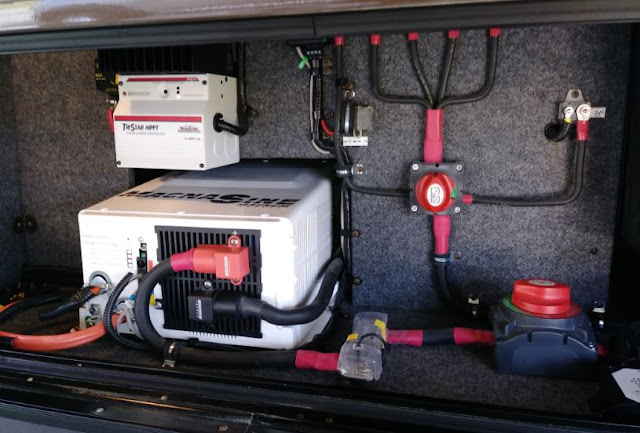During our stay at Congress, AZ in April this year we
finally discovered what the burning rope smell was that we had been catching
occasional whiffs of over the last few weeks during our winter visit in Yuma. At first we had dismissed the smell as exhaust
blowing back into our coach from running our refrigerator on propane on a windy
day. Later we noticed the smell when the
refrigerator was not running on propane, so that eliminated the refrigerator
exhaust theory. We had a few more clues
that we were not able to assimilate for a while.
We noticed the microwave oven surging during use on several occasions. We even measured the voltage on the microwave
circuit and observed it sagging from 120 VAC to about 107 VAC during a “voltage sag” event. The microwave is one of our largest current
using devices drawing ~17 Amps. We dismissed the voltage sagging situation to an
under-designed electric service at our RV lot.
Fast forward a few weeks, when we were just sitting down to dinner in
Congress, AZ when all the stars aligned for us.
Right after giving thanks and asking for blessings, we started to eat
and then we caught a whiff of the “burning rope smell”. The thought that we had just run the heavy
current using microwave oven, and that device is powered from the sub-panel
which gets its power through the inverter transfer switch… it was then we knew
we needed to inspect the inverter input-output terminal block immediately. We decided to do that as the first task in the morning, and we
were expecting to see a loose wire and some evidence of heating. Well those expectations were far exceeded
when we opened up the terminal block cover and observed the extent of the
heating and resultant melting and burning damage! We now know that we were extremely fortunate
to have avoided a more serious electrical fire.
Below are pictures of our inverter and the terminal block
cover; it looks innocent enough, but what lurks inside turned out to be
frightening.
This is the cover that encloses the input-output Terminal Block. The input and output conductors can be seen snaking in from the left of the picture and entering the inverter at the lower right of the picture below.
We pulled the terminal block out of the inverter for a
closer look. This is not good. An entire lug was burned and melted right off
of the terminal block! We knew
immediately that we had to make a change.
In fact when I first touched the screwdriver to the burned terminal lug,
to totally fell apart, so we would not be energizing our sub-panel through the
inverter until some change or repair was made.
We knew we would at least need replacement parts and even considered
replacing the entire inverter with a new replacement, but at $1,600 we thought
we would explore a lower cost repair first.
We decided that we would bypass the inverter immediately
until we figured out how we would recover the inverter through repair or replacement. In the picture below, we have removed the
input and output #10 AWG conductors going into and out of the inverter. The input comes from the Main distribution
panel and the output then feeds the Sub-distribution panel. Working with the #10 wires was not easy in
the tight spaces. That wire is very
thick and stiff. You can see the bottom wire that burned the most. It was a white wire! It burned the insulation completely off for about 3 inches, then another 2 inches was burned black. You can just see the original white color where the wire enters the cable insulation and black corrugated cable shielding.
In this shot below we have the input and output conductors
connected directly together which takes the inverter out of the sub-panel
circuitry. This way we can continue to use all of the circuits in or coach. Now we can take our time removing the inverter.
Below is the inverter out of its compartment and sitting on
our utility table in front of the coach.
The shot below shows where the inverter was. You can notice that we bypassed the inverter
by connecting the input and output connectors directly together at the left
side of the picture. The input black
wire is wire nutted with the output black wire, as are the red, white and
ground wires connected in the same fashion as the black wires. In this way we still had full use of all the
electrical circuits in our coach whilst we made repairs to the inverter.
Next step was to bring the inverter inside and pop the cover off and inspect for any further melting or burning, and then develop a parts list to replace all damaged parts and materials. There is the inverter below opened up on the kitchen table.
Disassembling the various circuit boards and noting where each wire goes so we will know where to replace them as we reassemble the inverter. The two internal neutral inverter wires melted and disconnected from the terminal lug!
A black wire connection...Top view. The large transformer at the upper left is very heavy, probably close to 50 pounds.
There's where the blue wire plugs in...
We found 4 wires internal to the inverter that had some melting and or burn damage. The two neutral output wires were the worst. Two additional wires, an orange and blue wire had superficial melting on thier insulation so we replaced them as well. Below we have the repaired inverter completely reinstalled and everything checked out. Everything was functioning as designed.
Final notes; our research found that a complete inverter replacement would have cost us more than $1,600. If we would have purchased the AC Board (which has the wires that were damaged) and their terminal block that would have been about a $500 repair. We went out and found the wire, the terminal block and connectors we needed all for about $50. This was a win this time, but it could have gone bad very easily. We will add this terminal block to our periodic torquing list to ensure that all wires a snug in their lugs. We did discover that it is not going to be easy and maybe not possible to torque the bottom row of terminal lugs which contain the inverter internal wires, without removing and disassembling the invert, or at least removing the cover. And that is the inverter excitement that we can all do without. We leave you with some pretty cactus flowers of North Ranch RV Park at Congress, AZ...





















Steve, what is your best assessment of the root functional cause of this problem?
ReplyDeleteJoel, I am highly certain that we had a loose terminal connection on the output neutral conductor. I am uncertain if it was the internal inverter conductors ( a pair of 12 ga stranded wires) or if it was the 10 ga solid external conductor. I suspect it was the stranded wires that became loose and that started the heating failure at that terminal lug.
ReplyDelete